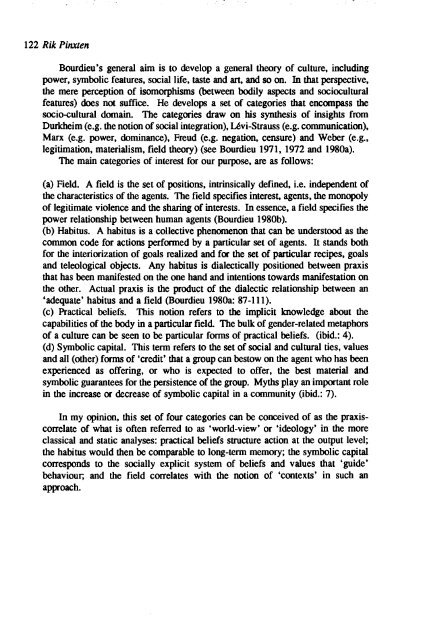1991 No. 1 CONTENTS - Institute of Social and Cultural ...
1991 No. 1 CONTENTS - Institute of Social and Cultural ...
1991 No. 1 CONTENTS - Institute of Social and Cultural ...
Create successful ePaper yourself
Turn your PDF publications into a flip-book with our unique Google optimized e-Paper software.
122 Rik Pinxten<br />
Bourdieu's general aim is to develop a general theory <strong>of</strong>. culture, including<br />
power, symbolic features, social· life, taste <strong>and</strong> art, <strong>and</strong> so on. In that perspective,<br />
the mere perception <strong>of</strong> isomorphisms (between bodily aspects <strong>and</strong> sociocultural<br />
features) does not suffice. He develops a set <strong>of</strong> categories that encompass the<br />
socio-cultural domain. The categories draw on his synthesis <strong>of</strong> insights from<br />
Durkheim (e.g. the notion <strong>of</strong> social integration), Uvi-Strauss (e.g. communication),<br />
Marx (e.g. power, dominance), Freud (e.g. negation, censure) <strong>and</strong> Weber (e.g.,<br />
legitimation, materialism, field theory) (see Bourdieu 1971, 1972 <strong>and</strong> 1980a).<br />
The main categories <strong>of</strong> interest for our purpose, are as follows:<br />
(a) Field. A field is the set <strong>of</strong> positions, intrinsically defined, i.e. independent <strong>of</strong><br />
the characteristics <strong>of</strong> the agents. The field specifies interest, agents, the monopoly<br />
<strong>of</strong> legitimate violence <strong>and</strong> the sharing <strong>of</strong> interests. In essence, a field specifies the<br />
power relationship between human agents (Bourdieu 1980b).<br />
(b) Habitus. A habitus is a collective phenomenon that can be understood as the<br />
common code for actions performed by a particular set <strong>of</strong> agents. It st<strong>and</strong>s both<br />
for the interiorization <strong>of</strong> goals realized <strong>and</strong> for the set <strong>of</strong> particular recipes, goals<br />
<strong>and</strong> teleological objects. Any habitus is dialectically positioned between praxis<br />
that has been manifested on the one h<strong>and</strong> <strong>and</strong> intentions towards manifestation on<br />
the other. Actual praxis is the product <strong>of</strong> the dialectic relationship between an<br />
'adequate' habitus <strong>and</strong> a field (Bourdieu 1980a: 87-111).<br />
(c) Practical beliefs. This notion refers to the implicit knowledge about the<br />
capabilities <strong>of</strong> the body in a particular field The bulk <strong>of</strong> gender-related metaphors<br />
<strong>of</strong> a culture can be seen to be particular forms <strong>of</strong> practical beliefs. (ibid.: 4).<br />
(d) Symbolic capital. This term refers to the set <strong>of</strong> social <strong>and</strong> cultural ties, values<br />
<strong>and</strong> all (other) forms <strong>of</strong> 'credit' that a group can bestow on the agent who has been<br />
experienced as <strong>of</strong>fering, or who is expected to <strong>of</strong>fer, the best material <strong>and</strong><br />
symbolic guarantees for the persistence <strong>of</strong> the group. Myths play an important role<br />
in the increase or decrease <strong>of</strong> symbolic capital in a community (ibid.: 7).<br />
In my opinion, this set <strong>of</strong> four categories can be conceived <strong>of</strong> as the praxiscorrelate<br />
<strong>of</strong> what is <strong>of</strong>ten referred to as 'world-view' or 'ideology' in the more<br />
classical <strong>and</strong> static analyses: practical beliefs structure action at the output level;<br />
the habitus would then be comparable to long-term memory; the symbolic capital<br />
corresponds to the socially explicit system <strong>of</strong> beliefs <strong>and</strong> values that 'guide'<br />
behaviour; <strong>and</strong> the field correlates with the notion <strong>of</strong> 'contexts' in such an<br />
approach.
















